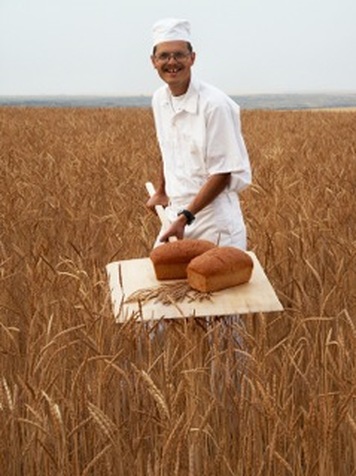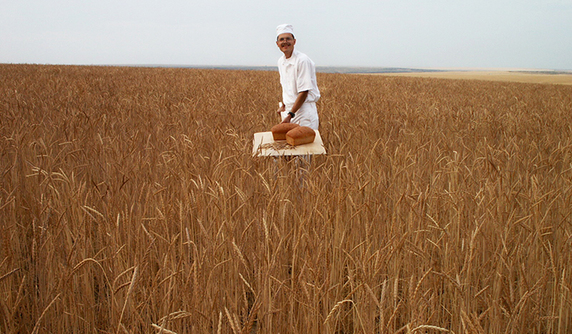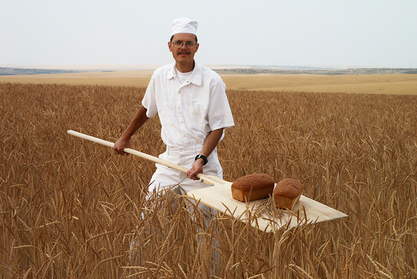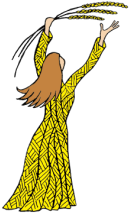FARRO NOT FERRO
In Scotland we met a most gracious hotelier who was also a very fine chef – Gino from Italy.
But when we mentioned that we were raising Farro grains in America, a strange look came over Gino’s face. That had us worried.
The next time we spoke with Gino, we asked him outright: Why the strange look when we mention Farro grains?
Well, he said, Ferro in Italian means iron.
Ever since, we pronounce Farro with the ‘a’ as in are.
But when we mentioned that we were raising Farro grains in America, a strange look came over Gino’s face. That had us worried.
The next time we spoke with Gino, we asked him outright: Why the strange look when we mention Farro grains?
Well, he said, Ferro in Italian means iron.
Ever since, we pronounce Farro with the ‘a’ as in are.
*****
BAKER STEVE OF THE FORMULAS

An outstanding artisan comes to be known by his art, that’s why Steve Caudill is “Baker Steve” among his friends and in his classes that teach the precise science of baking, a science designed for creative sensory delights.
Baker Steve once stopped by a wheat field at harvest, on his way home to Stevens County around Colville in northeastern Washington. “Where can I buy your wheat?,” he asked the farmer. “You can’t,” the grower answered, explaining how the wheat industry stores many farmers’ grain indiscriminately in elevator storages, which mixed wheat either gets exported, or blended by the train loads for roller mills where white flour is processed that functions the same year after year. Commodity wheat flour has become so anonymous, ubiquitous that as ingredient of many processed foods it’s simply listed as “Flour” – flour what?, wheat flour?, if so, what kind of wheat...
Appreciating the traveler’s interest in the grain he raised, the farmer let Baker Steve climb up to the hopper of his combine to dole out some wheat. Thanking the farmer for the gift, Baker Steve drove on in a sad state of mind. For someone who’s raised baking to an art form – “wheat is the canvas for my bread,” he once put it –, wheat as mere commodity does not make for an uplifting relationship.
A few years later Baker Steve got onto Spelt. And Emmer: the ancient grains of reverence. Grains that were the original Staff of Life. Baker Steve, quoting the Bible: “... bread which strengthened man's heart."
Now he could visit the fields of the grain he’d be milling for his flour. He could see the stands of the tall grass blessed by hot summer sun, a billion kernels ripening. The “canvas” for his art now belonged to a specific landscape – the plateau riven by shrub-steppe coulees –, and a specific soil of sandy loam, and a specific fragrance, dusty sweet, of Spelt grain harvest. Oh yes, Baker Steve got to ride high up in the cab of the John Deere combine, mesmerized by Spelt falling in waves and more waves into the wide header, tines turning, stubble in the wake.
For his Spelt farm visit Baker Steve had brought some loaves with him – of course, the man always takes bread on his travels –, and he’d also brought a peel, that very-long-handled wooden slate used to lift loaves from big ovens. Thus we had props for promotional photography; we’d decided to catch the intense lighting at sunrise, so before breakfast we bounced in the farm pick-up across furrows to where the combine had stopped cutting the previous day. A good picture, we thought, baker and grain stand and bread of a harvest morning.
We hadn’t figured on the huge black roil in the western sky. Already we could hear thunder. Jagged lightning stabbed from the cloud front, closing in fast. We hurried. A tinder-dry cereal field is not a place one should be at if lightning strikes it.
We’d barely scrambled into the pick-up when rain arrived, a squall driven so hard by gusts that the deluge streaked sideways. Now the wheat truck at field’s edge, half-full with Spelt, had to be tarped fast, which involved standing on a metal ladder while lightning shot close and thunder boomed nigh overhead.
It was as though the Heavens had been watching the baker-farmer photo shoot – authenticity is what you’re after?, here’s a reminder that Nature has her hand in the thick of it!
In less than a half an hour the storm had walked onto the horizon; by early afternoon the Spelt was dry again for cutting.
But for Baker Steve and for us it was one harvest morning we’ll remember for the rest of our lives.
*****

A lot of folks up in Stevens County got to know Baker Steve over the years. At regional fairs he won the Washington Wheat Growers Association Baking Award, and his classes, some within formal Community Education programs and some serving private groups such as homeschooling families, raised awareness of what artisan bread can be. For some time he worked in a bakery, a short-hours job. "People always ask me why I don't open my own bakery," he remarks. "Actually, what I really want to do is play around with formulas, and teach.” Francisco he’s always had a penchant for baking, he relates. "I grew up in the kitchen of my grandmother. I helped bake cookies, my brother helped bake bread. We lived in the country, with a big garden." This was back in Michigan.
For his professionalism he credits the Bread Bakers Guild of America and the San Francisco Baking Institute. “I’m thankful to my parents, they made it possible for me to attend several week-long seminars in artisan baking.”
In a nation awash with Wonderbread and Betty Crocker baking mixes (their recipes generated by General Mills), Institute and Guild expose one to a whole world of baking amazingly deep and diverse. We tend to forget the multitude of cultures who, back in the days of local grain, each developed their own bread arts. Time was when bread in one village tasted different than in the next, because flour was milled from one land-race grain here, from another land-race there, and the baking traditions also varied. Oh, but once you walk through that door to artful baking, there is no end to creativity – that’s how it was for Baker Steve –, so Guild and Institute duly deserve kudos for their role in unlocking what’s at the heart of the art.
The formulas Baker Steve teaches can be adapted to an astonishing 25,000 different-tasting types of bread, he estimates. His own list of ingredients he’s added to the dough of whole-grain bread include cooked rice, cooked beans, cooked polenta, cooked kamut, and sprouted barley, sprouted amaranth, sprouted quinoa, and also soaked bulgur wheat, soaked triticale flakes, soaked teff, soaked millet... A scrumptious drift without end.
He holds that few arts match the sensory experience of bread baking, all five senses attaining pleasure. "Your hearing is involved when during pre-ferment the poolish bubbles away, and when the steam hisses in the oven, and when the crust 'sings' as the bread comes out of the oven. The visual experience is when you see the texture of the dough change. The touch comes when you handle the dough. The smell's really strong during the baking, and taste, of course, is to eat the bread."
*****
Let’s listen in on one of Baker Steve’s classes at the home-economics room of the Colville High School. It’s the second evening of a two-night course which features Pain de Campagne, the famed “country bread” of the French.
Calculator held up, Baker Steve explains formula versus recipe, emphasizing the mathematical precision of formulas. Expressed as “baker’s percentage,” a formula is more logical, he insists: "What's the most prominent ingredient in bread? Flour, of course. Then why base a recipe on cups of water?”
In formulas, the flour always is designated 100 percent, and the other ingredients are calculated in percentage-relation to that 100 percent. Also, rather than measuring in volume – in the cups and spoons of recipes –, it’s more exact to translate the percentages into weight, specifically grams and kilograms because multiplication and division is much easier in the decimal system.
Here's how a standard bread recipe found in many cookbooks reads when expressed in percentages and grams:
Whole wheat flour - 100 percent, 1275 g.
Water - 80 percent, 1020 g.
Salt - 2 percent, 25.5 g.
Yeast - 1.2 percent, 15.3 g.
Oil - 5 percent, 64 g.
Honey - 4 percent, 51 g.
These measures will bake three loaves of 1 3/4 pound each, Baker Steve says, stressing the practicality of a baker’s-percentage formula: it’s easy to adjust to any desired scale; be it one bread or a hundred, that little calculator – he’s waving it again – does the trick.
In dough mixing Baker Steve also diverges from standard cookbook directions. Adding flour to the water until it becomes dough, he says is something like fallacy because it goes against the nature of gluten. "The combining of glutenin and gliadin with water forms the gluten, and not until the gluten forms can it develop." Slowly mixing the flour with only some of the water in the formula gives the gluten a chance to form, he says. After four to five minutes of hydration, the mixing then is speeded up for gluten development. "The length of mixing time depends on the dough characteristics you want to achieve."
At this point he recounts yesterday’s lesson which mainly dealt with the pre-ferment process. If that process takes extra time, it’s well worth it, he says: a pre-ferment greatly enhances bread flavor and crumb-structure characteristics. "When using a whole-wheat flour, you can pre-ferment anywhere from 20 percent to 70 percent of the total flour, at a hydration of 60 percent to 100 percent."
When flour and water are used in equal portion at pre-ferment, that's called "poolish."
Much of the bread diversity possible is a result of the great variability of the pre-ferment method, which in formulas is always expressed separately in baker's percentage.
Pre-ferment isn’t the only phase that precedes the oven; it’s important that the dough is allowed "resting time," then comes "shaping," and the "final proof" which is the last rise.
"Proof your bread on a couche, or use a banneton." The couche is a heavy cotton muslin sheet he's brought to class. The banneton is a wicker basket lined with a flour-sack towel.
"Now dust lightly with flour," Baker Steve instructs.
A dozen people dusting with flour in the home-ec room creates a little dance of white puffs, which explains why most students wear an apron to the class, and why at the door towels are laid out for wiping one's shoes before entering the carpeted hallway.
The next step involves a double-edge razor blade inserted into a "lamé," a special holder that allows the baker to execute quick but precise slashes across the dough. It looks easy when Baker Steve demonstrates, but everyone in the class experiences some awkwardness in transferring a pattern to the bread-shaped dough. Later, when the loaves come out of the ovens, the students will recognize their own breads by the pattern.
But now Baker Steve shows the proper use of the peel – the flat, shiny metal sheet with a handle –, and how to wield the transfer peel – a long, smooth wooden slate.
Finally, finally it's the turn of the ovens.
For his professionalism he credits the Bread Bakers Guild of America and the San Francisco Baking Institute. “I’m thankful to my parents, they made it possible for me to attend several week-long seminars in artisan baking.”
In a nation awash with Wonderbread and Betty Crocker baking mixes (their recipes generated by General Mills), Institute and Guild expose one to a whole world of baking amazingly deep and diverse. We tend to forget the multitude of cultures who, back in the days of local grain, each developed their own bread arts. Time was when bread in one village tasted different than in the next, because flour was milled from one land-race grain here, from another land-race there, and the baking traditions also varied. Oh, but once you walk through that door to artful baking, there is no end to creativity – that’s how it was for Baker Steve –, so Guild and Institute duly deserve kudos for their role in unlocking what’s at the heart of the art.
The formulas Baker Steve teaches can be adapted to an astonishing 25,000 different-tasting types of bread, he estimates. His own list of ingredients he’s added to the dough of whole-grain bread include cooked rice, cooked beans, cooked polenta, cooked kamut, and sprouted barley, sprouted amaranth, sprouted quinoa, and also soaked bulgur wheat, soaked triticale flakes, soaked teff, soaked millet... A scrumptious drift without end.
He holds that few arts match the sensory experience of bread baking, all five senses attaining pleasure. "Your hearing is involved when during pre-ferment the poolish bubbles away, and when the steam hisses in the oven, and when the crust 'sings' as the bread comes out of the oven. The visual experience is when you see the texture of the dough change. The touch comes when you handle the dough. The smell's really strong during the baking, and taste, of course, is to eat the bread."
*****
Let’s listen in on one of Baker Steve’s classes at the home-economics room of the Colville High School. It’s the second evening of a two-night course which features Pain de Campagne, the famed “country bread” of the French.
Calculator held up, Baker Steve explains formula versus recipe, emphasizing the mathematical precision of formulas. Expressed as “baker’s percentage,” a formula is more logical, he insists: "What's the most prominent ingredient in bread? Flour, of course. Then why base a recipe on cups of water?”
In formulas, the flour always is designated 100 percent, and the other ingredients are calculated in percentage-relation to that 100 percent. Also, rather than measuring in volume – in the cups and spoons of recipes –, it’s more exact to translate the percentages into weight, specifically grams and kilograms because multiplication and division is much easier in the decimal system.
Here's how a standard bread recipe found in many cookbooks reads when expressed in percentages and grams:
Whole wheat flour - 100 percent, 1275 g.
Water - 80 percent, 1020 g.
Salt - 2 percent, 25.5 g.
Yeast - 1.2 percent, 15.3 g.
Oil - 5 percent, 64 g.
Honey - 4 percent, 51 g.
These measures will bake three loaves of 1 3/4 pound each, Baker Steve says, stressing the practicality of a baker’s-percentage formula: it’s easy to adjust to any desired scale; be it one bread or a hundred, that little calculator – he’s waving it again – does the trick.
In dough mixing Baker Steve also diverges from standard cookbook directions. Adding flour to the water until it becomes dough, he says is something like fallacy because it goes against the nature of gluten. "The combining of glutenin and gliadin with water forms the gluten, and not until the gluten forms can it develop." Slowly mixing the flour with only some of the water in the formula gives the gluten a chance to form, he says. After four to five minutes of hydration, the mixing then is speeded up for gluten development. "The length of mixing time depends on the dough characteristics you want to achieve."
At this point he recounts yesterday’s lesson which mainly dealt with the pre-ferment process. If that process takes extra time, it’s well worth it, he says: a pre-ferment greatly enhances bread flavor and crumb-structure characteristics. "When using a whole-wheat flour, you can pre-ferment anywhere from 20 percent to 70 percent of the total flour, at a hydration of 60 percent to 100 percent."
When flour and water are used in equal portion at pre-ferment, that's called "poolish."
Much of the bread diversity possible is a result of the great variability of the pre-ferment method, which in formulas is always expressed separately in baker's percentage.
Pre-ferment isn’t the only phase that precedes the oven; it’s important that the dough is allowed "resting time," then comes "shaping," and the "final proof" which is the last rise.
"Proof your bread on a couche, or use a banneton." The couche is a heavy cotton muslin sheet he's brought to class. The banneton is a wicker basket lined with a flour-sack towel.
"Now dust lightly with flour," Baker Steve instructs.
A dozen people dusting with flour in the home-ec room creates a little dance of white puffs, which explains why most students wear an apron to the class, and why at the door towels are laid out for wiping one's shoes before entering the carpeted hallway.
The next step involves a double-edge razor blade inserted into a "lamé," a special holder that allows the baker to execute quick but precise slashes across the dough. It looks easy when Baker Steve demonstrates, but everyone in the class experiences some awkwardness in transferring a pattern to the bread-shaped dough. Later, when the loaves come out of the ovens, the students will recognize their own breads by the pattern.
But now Baker Steve shows the proper use of the peel – the flat, shiny metal sheet with a handle –, and how to wield the transfer peel – a long, smooth wooden slate.
Finally, finally it's the turn of the ovens.
*****

The home-ec room has five stations with the type of electric stove you find in the majority of American households. For artisan bread the ovens need adapting. Fire bricks are arranged in a layer on the bottom oven shelf, and a cast-iron pan with water is also set inside the oven. And, a garden pressure sprayer stands at ready filled with water.
"You want to use a new sprayer so you're sure that it only had water in it," Baker Steve admonishes.
The pre-heated ovens hiss when the water spray hits the loaves early in the baking. That steam produces the hard crust of European breads, "crust caramelization” the scientific term, Baker Steve says. "Also, the steam and the strongly conductive bottom heat give the bread good 'oven spring'."
While the loaves bake we reflect on bread through the ages, as many breads as there were cultures. Not to mention the ten-thousands of land-race cereals.
Baker Steve is asked what kind of folks attend his classes. "They’re people who got tired of the mediocre bread you buy at the superstores," he answers. "All of them are 'foodies'. For me the great joy is when I see them catch on to the concept of artisan baking.”
Some of the wishful artisans make comments about the class. Janet Prolo, of Pleasant Valley, tells us that she's baked bread all her life. "But I always baked what I call farm bread, four loaves in four hours, using only whole-wheat and white flour." Not only did the course open her eyes to cereal grain diversity, but the pre-ferment process impressed her as "very involved, a little like making beer."
Dave Garrett, of Colville, enjoyed the "chemical and math aspects" of the class. No wonder this – Garrett’s a retired clinical chemistry consultant. He, too, despises supermarket attributes: "What you buy in the store I call 'balloon bread' because it's like eating air." Garrett also baked bread previously, although he does not consider it "real bread" because he used a bread machine. "There is a lot more to this artisan bread than I thought," he says.
As the last loaves of the class are lifted from the ovens, sharp bread knives come out and the loaves are divided among the class. Paper bags rustle. End-of-class conversation is casual as everybody helps with the clean-up. Good-byes are said, and thank-yous.
In the hallway the janitor's vacuum cleaner hums. Baker Steve, relaxed now after the class he'd moved along at tour-de-force pace, gathers his bricks and his books, and what's left of the flours he'd milled for the class, and his little sprayer and his peel and transfer peel, and all his other accoutrements of artisan baking.
On carts he rolls the stuff down the hallway to the door to load his car. Outside, cold Colville winter surrounds the school now still in the night – the more memorable the baking aromas when the ovens had opened.
His old car rasps when he turns the ignition key. On the fourth try the motor turns over. Smiling, Baker Steve waves good bye.
"You want to use a new sprayer so you're sure that it only had water in it," Baker Steve admonishes.
The pre-heated ovens hiss when the water spray hits the loaves early in the baking. That steam produces the hard crust of European breads, "crust caramelization” the scientific term, Baker Steve says. "Also, the steam and the strongly conductive bottom heat give the bread good 'oven spring'."
While the loaves bake we reflect on bread through the ages, as many breads as there were cultures. Not to mention the ten-thousands of land-race cereals.
Baker Steve is asked what kind of folks attend his classes. "They’re people who got tired of the mediocre bread you buy at the superstores," he answers. "All of them are 'foodies'. For me the great joy is when I see them catch on to the concept of artisan baking.”
Some of the wishful artisans make comments about the class. Janet Prolo, of Pleasant Valley, tells us that she's baked bread all her life. "But I always baked what I call farm bread, four loaves in four hours, using only whole-wheat and white flour." Not only did the course open her eyes to cereal grain diversity, but the pre-ferment process impressed her as "very involved, a little like making beer."
Dave Garrett, of Colville, enjoyed the "chemical and math aspects" of the class. No wonder this – Garrett’s a retired clinical chemistry consultant. He, too, despises supermarket attributes: "What you buy in the store I call 'balloon bread' because it's like eating air." Garrett also baked bread previously, although he does not consider it "real bread" because he used a bread machine. "There is a lot more to this artisan bread than I thought," he says.
As the last loaves of the class are lifted from the ovens, sharp bread knives come out and the loaves are divided among the class. Paper bags rustle. End-of-class conversation is casual as everybody helps with the clean-up. Good-byes are said, and thank-yous.
In the hallway the janitor's vacuum cleaner hums. Baker Steve, relaxed now after the class he'd moved along at tour-de-force pace, gathers his bricks and his books, and what's left of the flours he'd milled for the class, and his little sprayer and his peel and transfer peel, and all his other accoutrements of artisan baking.
On carts he rolls the stuff down the hallway to the door to load his car. Outside, cold Colville winter surrounds the school now still in the night – the more memorable the baking aromas when the ovens had opened.
His old car rasps when he turns the ignition key. On the fourth try the motor turns over. Smiling, Baker Steve waves good bye.
*****

Baker Steve has left America. Sometimes he sends photos of the Andes in his e-mails. He’s on a mission in Bolivia. You bet, he’s teaching baking there.
Good for Bolivia. At Colville they miss him. At the Spelt farm, too.
© 2013 Lentz Spelt Farms
Good for Bolivia. At Colville they miss him. At the Spelt farm, too.
© 2013 Lentz Spelt Farms

